Excerpts from Jim Conrad's
Naturalist Newsletter
Entry dated February 8, 2024, issued from near Tequisquiapan; elevation about 1,900m, (6200 ft), ~N20.57°, ~W99.89°; Querétaro state, MÉXICO
PRICKLYLEAF

The above population of small, gray-leafed, mat-forming bushes inhabited the center of a large, abandoned, grossly overgrazed and eroded field. They formed a conspicuous little island of color other than that of the parched landscape's dun-hued, exposed dirt and scattered, parched-crisp, tufts of sheep-cropped grass. We're experiencing the usual dry season during a continuing, two-year period which the North American Drought Monitor classifies as a D3 Extreme Drought, so any plant thriving in this environment deserved attention.
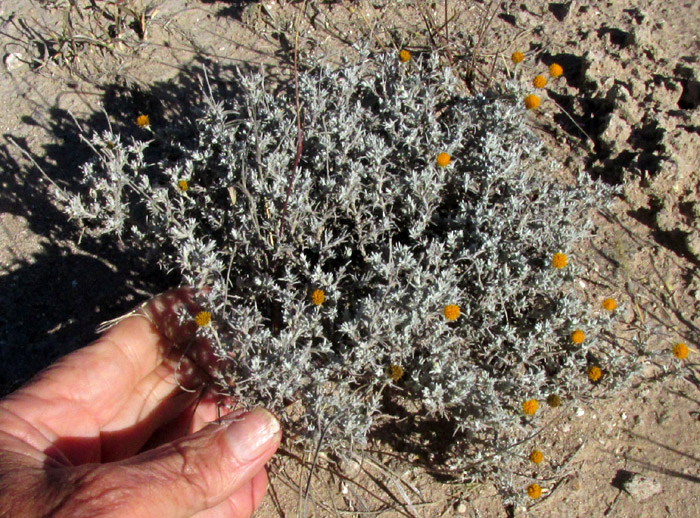
The dense, much-branched little shrub bore diminutive, orange flowering heads, and similarly small stems and leaves.
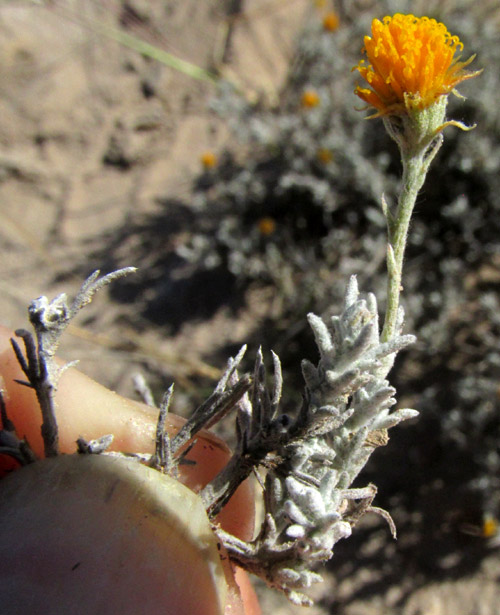
Viewed from the side, the shrub's flowering heads topped vertical stems conspicuously rising above the plant body. Typical of the largest and most diverse of all plant families, the Composite/Aster/Sunflower Family, the Asteraceae, the heads consisted of many small, orange florets gathered within a gray, bowl-like involucre.
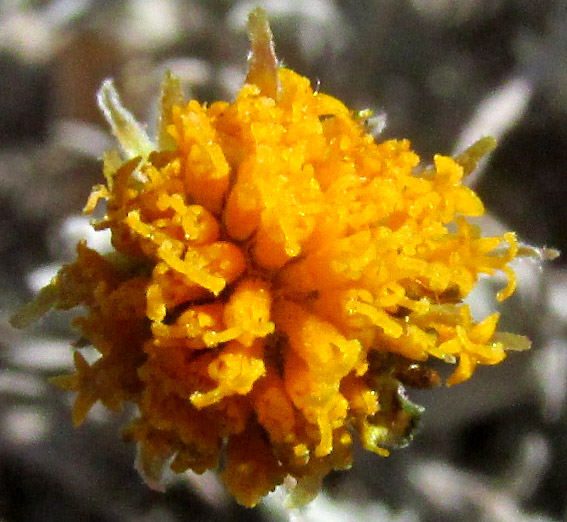
At the right, the flowering head, or capitulum, seen from above is composed only of disc florets with cylindrical corollas; no petal-like ray floret radiate from around the head's periphery. The pale items radiating outward are the tips of scale-like phyllaries forming the involucre below the florets, and are better seen below:
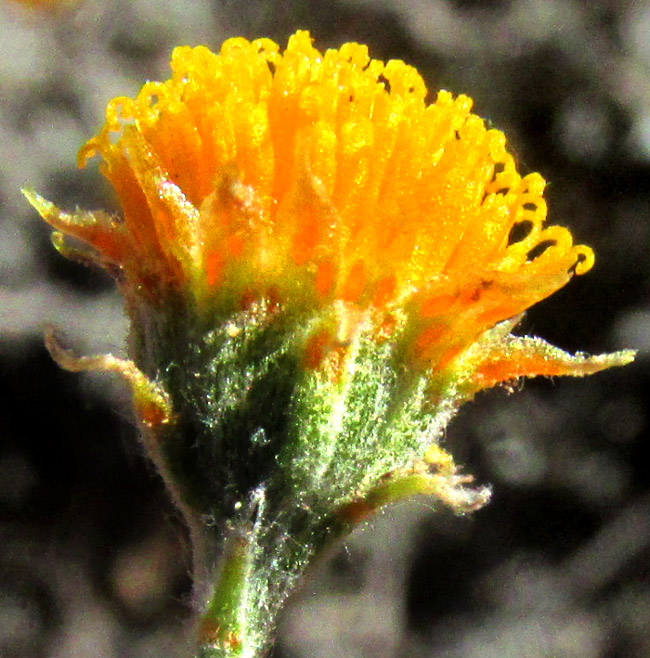
Later, I'd have trouble identifying this species because of being led astray by the above picture. The Aster Family, because of its enormity, is divided into tribes composed of genera. Our shrub later was found to belong to the marigold tribe, the Tageteae. Our plant's florets had the typical marigold color, but the scale-like phyllaries below florets of species in the marigold tribe are recognized by possessing circular, pustular glands. I simply saw no glands on these phyllaries, though I'm told that they're there. Also, the phyllaries of most species in that tribe are mostly to completely fused at their bases with neighboring phyllaries. Our phyllaries have fused bases, except for the very lowest ones. Not seeing glands in the green spaces between the white hairs cost several hours of fruitless searching for an identity
.
The above dissected capitulum shows that pappi atop the one-seeded, cypsela-type fruits consisted of crownlike series of short, orangish, hard-to-see scales. No scale-like paleae occur between the cypselae, and the cypselae themselves stand atop a steeply convex platform, or receptacle.
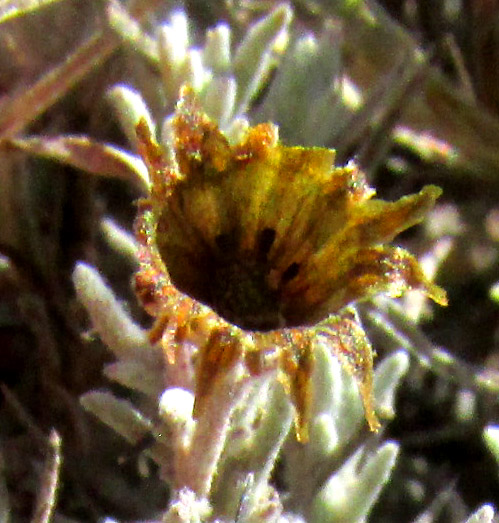
The above was the only remaining empty involucre from the previous season. The "persistent involucre" is a useful identification feature.
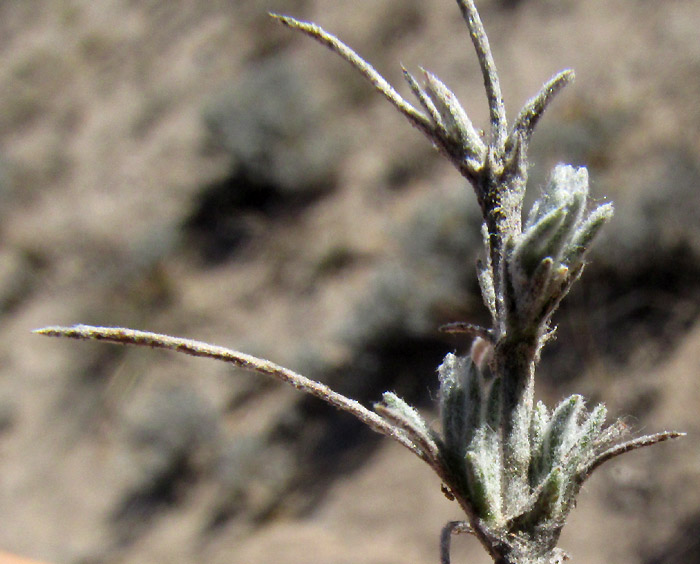
Each of the long, slender items seen above is a leaf; two leaves arise opposite one another at each stem node. Each leaf bears short, slender lobes at its base.
All the above features led me, erroneously, to the Yellow Pincushion, Chaenactis glabriuscula. However, that species is native to the southwestern US, extending into Mexico only in Baja California. The genus is assigned to the "pincushion tribe," the Chaenactideae, which on the Phylogenetic Tree of Life appears near the Marigold Tribe I'd learn that our plant belongs to. Fortunately, I noticed that our plants differed in certain subtle ways from the Yellow Pincushion, so I resisted naming it that. For example, on the Yellow Pincushion, corollas of outer florets are more bilaterally symmetrical than on our plant, and plant parts tend to be larger. Also, glands on Yellow Pincushion phyllaries are described as short-stalked, not pustular like those supposed to occur on our plant.
Unable to name our plant and knowing that Dr. José Luis Villaseñor at UNAM, Mexico's main university in Mexico City, specializes in the Aster Family in Mexico, and hoping the above pictures would be of interest to him, they were sent to him. He replied that our plants looked like THYMOPHYLLA SETIFOLIA. He said that by looking carefully he could see orange glands in the pictures.
Thymophylla setifolia, far from being taxonomically interesting, somewhat commonly occurs in highland, deserty grasslands, degraded pastures and even roadsides from New Mexico and Texas in the north, to about our location in central Mexico, and spottily south into Oaxaca. In the US it's called the Texas Pricklyleaf, but the species is much more Mexican than Texan. Currently at least two varieties are recognized; ours is the typical one, variety setifolia. Adding to this species' tricky appearance, it's described as sometimes developing petal-like ray florets; this is really a tricky one.
Especially when browsing the diverse-looking species assigned to the two tribes dealt with here, it's even more striking that our Pricklyleaf is so similar in so many small details to the Yellow Pincushion. I'm guessing that it's a matter of convergent evolution -- where the descendants of two not particularly closely related species evolve adaptations for a particular habitat, and end up producing very similar taxa. Yellow Pincushion is composed of perhaps five varieties, of which the form most similar to our plants is the one extending into Mexico's Baja California. There, it occupies dry, sandy, scrubby places similar to our droughty, overgrazed field.
In the 2017 work by Eduardo Estrada and others entitled "Ethnobotanical Survey of Useful Species in Bustamante, Nuevo León, Mexico," it's reported that Thymophylla setifolia leaves, inflorescences and flowers are boiled to prepare a drink to treat sore throat. When I'd nibbled a sprout, there was a slightly bitter but not unpleasant taste and I thought to myself that it tasted like something that might be used for sore throats. So, there you go.
The greatest ecological service this little shrub offers clearly is that it can thrive in drought-stricken, soil-abused, profoundly degraded grasslands where few other plants survive. As such, it holds in place what soil it can, and provides habitat for untold numbers of living things needing shelter and food.